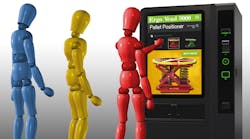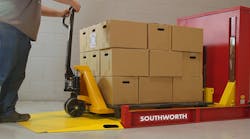Material Handling Equipment Makers Focus on Flexibility
The material handling equipment market is on the move. Manufacturers are churning out new equipment to keep pace with increasing demand as warehouses and distribution centers try to adapt to a constantly changing and more demanding market.
The global market is expected to reach $41.2 billion by 2025, at a CAGR of 6.8%, according to a study conducted by Grand View Research Inc. Another study by Global Market Insights attributes industry growth to increasing demand for automated solutions as organizations grapple with rising labor costs in the material handling segment.
NED recently spoke with Jim Galante, director of business development at Southworth Products Corp., a maker of ergonomic material handling equipment, to discuss these trends and how the material handling equipment industry is addressing the need for a wider, more versatile range of solutions on shorter lead times.
NED: What’s driving this push for on-demand access to different types of material handling equipment?
JG: One observation is more demand from end users for manufacturers to increase product offerings in the form of more colors, more sizes, and different packaging options. Buyers might want a six pack instead of a 12 pack or an 18 pack instead of 12 pack. They may want it in cans, bottles, plastic, or bags in boxes. In some cases, the customer might want biodegradable packaging that is eco-friendly, and every time this happens, it creates another SKU.
And it’s not just customers making these requests, we see competitors driving change. If one brand all the sudden decides to put sour cream in squeezable bags, the competitor needs to have an equally appealing product. So, in short order they need to retool and reorganize their manufacturing process. You can imagine what that does to material handling equipment. Everything has to be adjusted, and quickly. They don’t plan for it, and they may realize they can retool the production capabilities pretty quickly, but the material handling issues are usually the last to be cleared, and all of the sudden you have cases coming out of the machine that have to be palletized or containerized in a different way and the existing equipment might not be the best solution for doing it faster, safer, and easier — so new equipment is needed.
Material handling equipment suppliers need to respond quickly to the demand for equipment because if they don’t the manufacturer is going to find somebody who can do it. The old adage that people will pay for convenience has never been more true. The manufacturers that can produce that equipment and ship it quickly are the ones that are going to be able to capture new accounts and distinguish themselves from their competition.
NED: Have consumer purchasing trends found their way into the industrial marketplace?
JG: To some extent yes. More and more the first question our sales group is asked is, “How quickly can I get it?” Sometimes the basis for the question is an imperative need as I discussed earlier, but sometimes it’s because things like online purchasing and same day delivery have created an expectation of immediate service. Often customers don’t “need” the product for a few weeks or even longer, but they still have that immediate expectation. The ability to deliver industrial equipment, especially customized products, can be a significant competitive advantage. In addition to speed, buyers want customization. Remember the slogan, “Have it your way.”? If we can offer buyers multiple solutions that include standard options and maybe even some customization and still ship in a matter of days instead of weeks, we’ve given our customers real value.
NED: How are you addressing this need for just-in-time delivery of material handling equipment?
JG: The key word is flexibility. Everybody from the manufacturer to the warehouse to the retail store needs to be flexible. At Southworth, we need to be able to produce not only pallet positioners, lift tables, and tilters, we have to customize them because that’s what our customers are demanding today. We had to take a look at our manufacturing process, not only to make the product but to customize it to suit the demands of our customers. Today, we have more inventory, not just in bulk but a variety of different inventories of various goods.
NED: What types of material handling equipment are your customers requesting as they try to accommodate new market demands?
JG: We see a lot of equipment today that is not stationary. Equipment used to be bolted to the floor or put in pits; quite permanent. Today, the flexibility that I previously mentioned requires that the equipment be portable. The lift tables, the tilters, the positioners like Southworth’s PalletPal – all of those products that can be easily moved around lend themselves to this flexibility. People are looking for things that can be easily converted and changed without having to throw it away and start over again. I use sour cream as an example because my wife has been buying it for years in tubs. The other day at the kitchen table she had a squeeze bag with sour cream in it. I asked her what it was, and she said, “This is the way they’re packaging it now, and I really like it.” All of the sudden, competitors need to come up with a squeeze bag, which not only entirely changes their packaging but how they’re going to handle the cases and how they’re going to prepare them for shipping. It’s things like this that are creating all kinds of issues and forcing engineers to look at converting production lines, shelving, racks and material handling equipment that’s adaptable to these changes and do it quickly. They don’t want changes next month. They want changes this week.
For more information, please visit www.SouthworthProducts.com

















